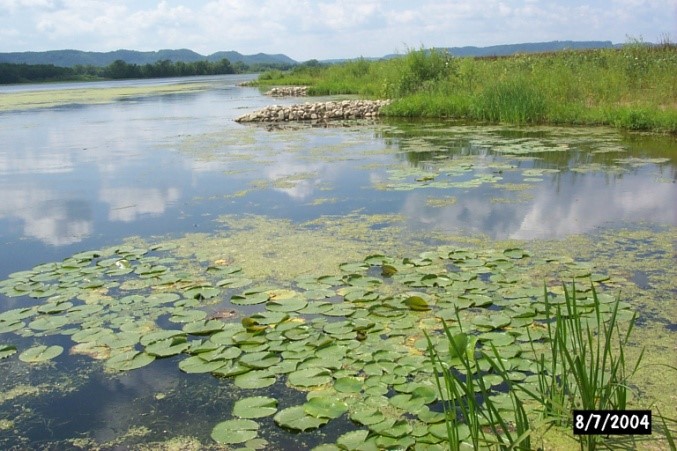 One of the U.S. Army Corps of Engineers’ critical missions is to strive for environmental sustainability. The St. Paul District recognizes the interdependence of life and the importance of the physical environment and proactively considers environmental consequences of its programs. Our goal is to seek balance and synergy among human development and natural systems by designing economic and environmental-friendly solutions that reinforce one another. Our environmental programs focus on the key areas of ecosystem preservation, restoration and protection.
One of the U.S. Army Corps of Engineers’ critical missions is to strive for environmental sustainability. The St. Paul District recognizes the interdependence of life and the importance of the physical environment and proactively considers environmental consequences of its programs. Our goal is to seek balance and synergy among human development and natural systems by designing economic and environmental-friendly solutions that reinforce one another. Our environmental programs focus on the key areas of ecosystem preservation, restoration and protection.
Stewardship of land managed by the district
It is the policy of the St. Paul District to apply principles of good environmental stewardship to the natural and cultural resources located on Corps-administered federal lands. The district manages more than 77,000 acres of land and more than 400,000 permanent easements across the Upper Midwest – an area equivalent to around 745 square miles. On these lands, the district’s natural resources staff is responsible for grassland, fisheries, forest and wetland management; regulating public use; managing water levels; establishing and enhancing vegetation; shoreline stabilization and more. The staff closely coordinates all of its activities on its river lands with other federal and state natural resource agencies.
Regulatory Program
The St. Paul District regulates structures and work in navigable waters of the United States under Section 10 of the Rivers and Harbors Act of 1899 and the discharge of dredged or fill material in waters of the United States under Section 404 of the Clean Water Act for the states of Minnesota and Wisconsin. Aquatic resources are abundant in Minnesota and Wisconsin, with 25% of the area covered by around 20,000 lakes, 15 million acres of wetlands and 100,000 miles of streams. The office averages around 5,000 requests annually and has contributed to the restoration and enhancement of more than 75,000 acres of wetlands that support important functions such as water quality and supply, recreation, fish and wildlife habitat and flood risk reduction. The staff is committed to the national program goal of allowing reasonable development through fair and balanced permit decisions.
Aquatic Ecosystem Restoration
Section 206 of the Water Resources Development Act of 1996 provides authority for the Corps to undertake restoration projects in aquatic ecosystems, such as rivers, lakes and wetlands. The Corps evaluates projects that benefit the environment through restoring, improving or protecting aquatic habitat for plants, fish and wildlife. A project is accepted for construction after an investigation shows it is technically feasible, environmentally acceptable and provides cost-effective environmental benefits. Costs for Section 206 projects are shared between the federal government (65%) and a non-federal sponsor or partner (35%), in accordance with the Water Resources Development Act of 1996. The maximum federal expenditure per project is
$10 million, which includes both planning and construction costs. The federal government will not pay the costs involved for obtaining the lands and/or easements and future operation and maintenance.
Upper Mississippi River Restoration Program
This systemic program provides a well-balanced combination of habitat restoration activities, along with monitoring and research. Planned and engineered by the Corps, in partnership with other organizations and the public, typical habitat projects include restoring islands, constructing flow control structures or shoreline stabilization features and dredging backwater areas. The program has pioneered many new and innovative engineering and planning techniques for ecosystem restoration in large river systems. The science element of UMRR has developed state-of-the-art techniques to monitor and conduct research on the river. The St. Paul District has completed more than 30 habitat rehabilitation and enhancement projects affecting more than 50,000 acres of river and floodplain habitat.
Habitat Restoration
The Corps has the authority, provided by Section 1135 of the Water Resources Development Act of 1986, as amended, to plan, design and construct fish and wildlife habitat restoration measures. To be eligible for consideration, restoration measures must involve modification of the structures or operations of a project constructed by the Corps, or modification of an off-project site when it is found the Corps’ project contributed to the degradation of the environment. To qualify under this program, projects must be justified – that is, the benefits resulting from constructing the project must exceed the cost incurred to design and build the project. Each separate project is limited to a total federal cost of not more than $10 million, including studies, plans and specifications and construction.
Environmental Infrastructure Projects
The St. Paul District’s environmental infrastructure programs assist rural communities with building, designing and/or restoring environmentally-friendly water supply and wastewater treatment systems. As of 2024, the district has assisted more than 56 communities in building 75 projects. The total cost for these projects was approximately $74 million.